The Ultimate Guide to Cucumber Tomato Onion Salad
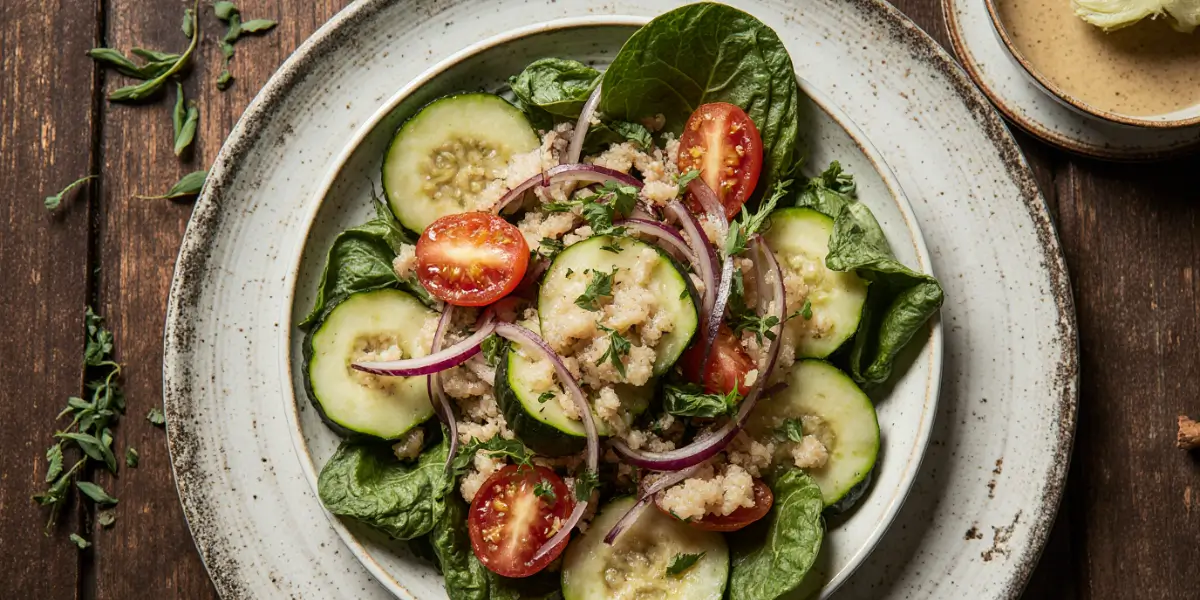
Picture this: it’s a sweltering summer afternoon, and you’re craving something light, refreshing, and bursting with flavor. You open your refrigerator to find a few simple ingredients—crisp cucumbers, juicy tomatoes, and sharp onions—and suddenly, you’re transported back to your grandmother’s kitchen, where she’d whip up the most incredible cucumber tomato onion salad that somehow made even the simplest vegetables taste like pure magic.
This isn’t just nostalgia talking. There’s something truly special about a well-crafted cucumber tomato onion salad that goes beyond its humble ingredients. It’s a dish that celebrates the beauty of simplicity, the power of fresh produce, and the art of letting natural flavors shine. Whether you’re looking for a quick side dish, a healthy lunch option, or the perfect accompaniment to your summer barbecue, this classic salad delivers on every front.
In this comprehensive guide, you’ll discover everything you need to know about creating the perfect cucumber tomato onion salad, from selecting the best ingredients to mastering flavor combinations that will have your taste buds dancing with joy.
The Perfect Foundation: Selecting Your Ingredients for Cucumber Tomato Onion Salad
The secret to an exceptional cucumber tomato onion salad lies in the quality of your ingredients. Since this salad relies on just a few key components, each one must be at its absolute best to create that perfect harmony of flavors and textures.
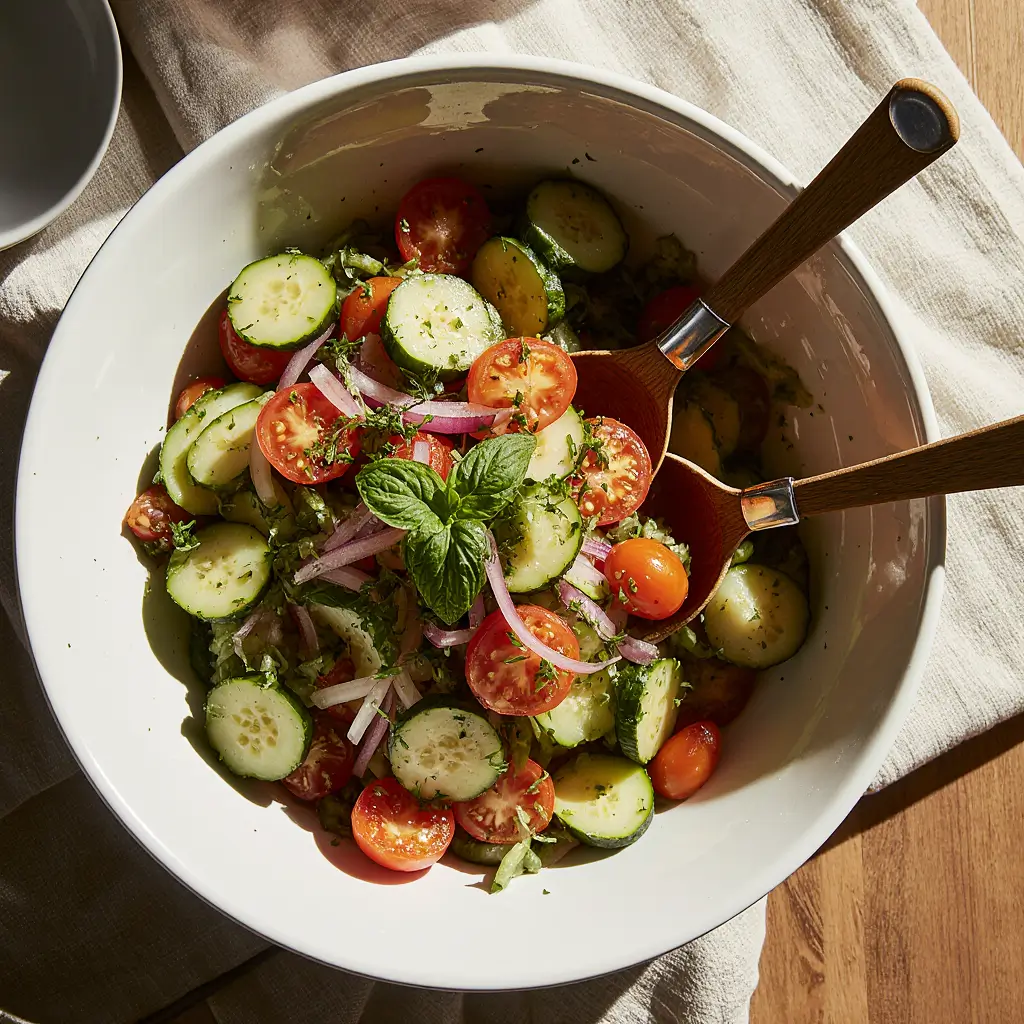
Choosing the Right Cucumbers
Your cucumber selection can make or break your salad. Look for cucumbers that are firm to the touch, with a vibrant green color and no soft spots or wrinkles. English cucumbers are often preferred for salads because they have fewer seeds and a milder flavor, but regular cucumbers work wonderfully too. If you’re using regular cucumbers, consider peeling them in alternating strips to create an attractive striped pattern while maintaining some of the nutritional benefits of the skin.
The key is to slice your cucumbers uniformly—about ¼ inch thick works perfectly. This ensures even distribution of flavors and creates the ideal texture contrast with the other ingredients. Some prefer to salt their cucumber slices and let them drain for 15-20 minutes before adding them to the salad, which removes excess moisture and concentrates the flavor.
Selecting Premium Tomatoes
Tomatoes are the heart of your cucumber tomato onion salad, providing that burst of juicy sweetness that balances the crisp cucumbers and sharp onions. Choose tomatoes that are ripe but still firm, with a deep red color and a slight give when gently pressed. Avoid tomatoes that are overly soft or have blemishes, as these can make your salad soggy.
For the best flavor, try to use vine-ripened tomatoes when possible. Cherry tomatoes or grape tomatoes can add a delightful pop of sweetness, while beefsteak tomatoes provide substantial, meaty chunks. Roma tomatoes are excellent for those who prefer less juice in their salad, as they have fewer seeds and more flesh.
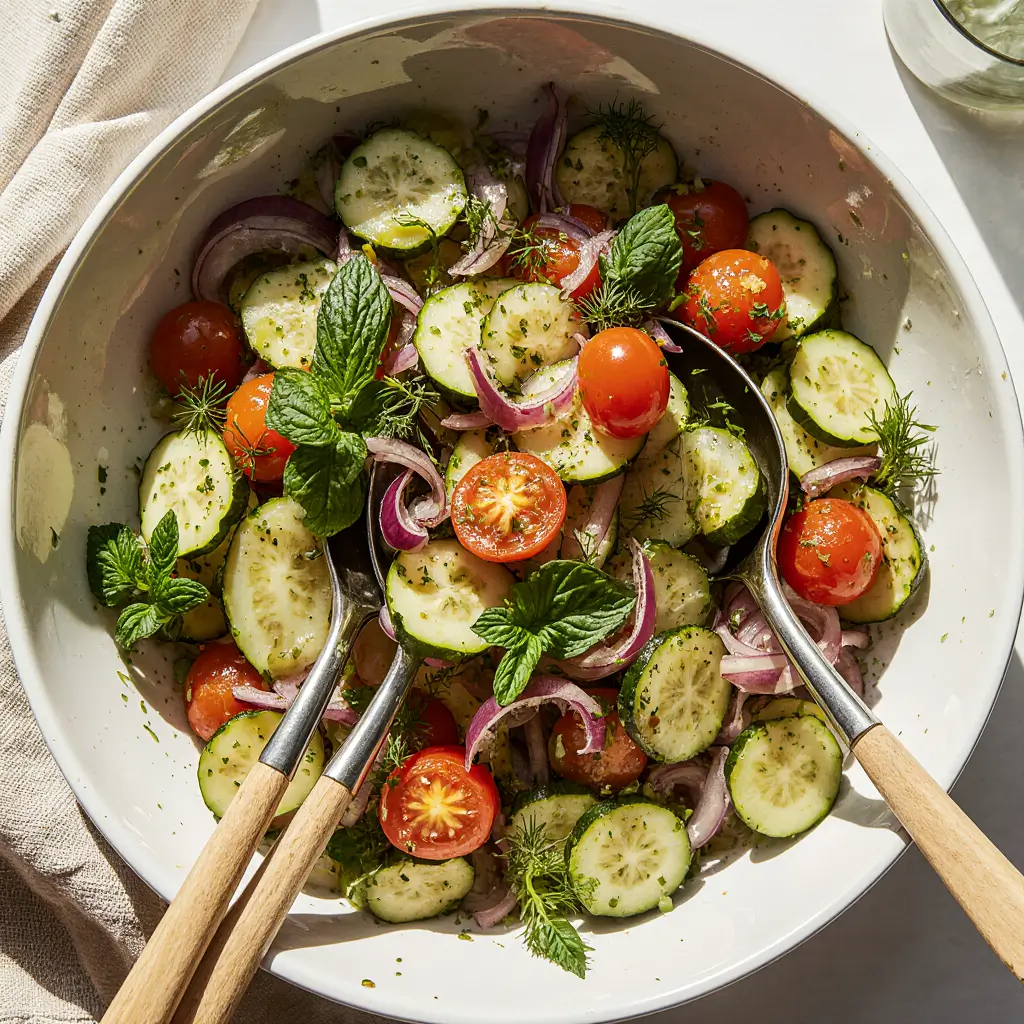
Onion Varieties and Preparation
The onion component of your cucumber tomato onion salad provides that essential sharp bite that awakens all the flavors. Red onions are the classic choice, offering a beautiful color contrast and a slightly milder flavor than yellow onions. Their purple-red hue also adds visual appeal to your salad.
If you find raw onions too strong, try soaking your sliced onions in cold water for 10-15 minutes before adding them to the salad. This technique mellows their bite while maintaining their crunch. For those who prefer a gentler onion flavor, sweet onions like Vidalia or Walla Walla are excellent alternatives.
Mastering the Art of Cucumber Tomato Onion Salad Preparation
Creating the perfect cucumber tomato onion salad isn’t just about throwing ingredients together—it’s about understanding how each component contributes to the overall experience and how proper preparation techniques can elevate your salad from good to extraordinary.
Essential Cutting Techniques
The way you cut your vegetables significantly impacts both the visual appeal and the eating experience of your cucumber tomato onion salad. Consistency is key—aim for pieces that are similar in size so that each bite contains a perfect balance of all three ingredients.
For cucumbers, slice them into rounds about ¼ inch thick, or if you prefer, cut them into half-moons for easier eating. Tomatoes should be cut into wedges or chunks that are roughly the same size as your cucumber pieces. This ensures that the flavors marry well and that you get a bit of everything in each forkful.
When it comes to onions, thin slices work best. They should be thin enough to provide flavor without overwhelming the other ingredients, but not so thin that they disappear entirely. A sharp knife is essential here—dull knives can crush the onion cells, releasing more of those tear-inducing compounds and making the onions taste harsher.
Timing and Assembly Methods
The timing of when you assemble your cucumber tomato onion salad can dramatically affect its final texture and flavor. Some prefer to dress the salad immediately and let it marinate for 30 minutes to an hour, allowing the flavors to meld together beautifully. Others prefer to add the dressing just before serving to maintain maximum crispness.
For the best of both worlds, consider adding the onions and dressing to the tomatoes first, letting them marinate for about 30 minutes, then adding the cucumbers just before serving. This allows the tomatoes to absorb the flavors while keeping the cucumbers crisp and fresh.
Seasoning and Flavor Balance
The seasoning of your cucumber tomato onion salad should enhance the natural flavors of the vegetables without overpowering them. Start with a generous pinch of salt, which helps draw out the natural juices of the tomatoes and creates a light, flavorful dressing when combined with the other ingredients.
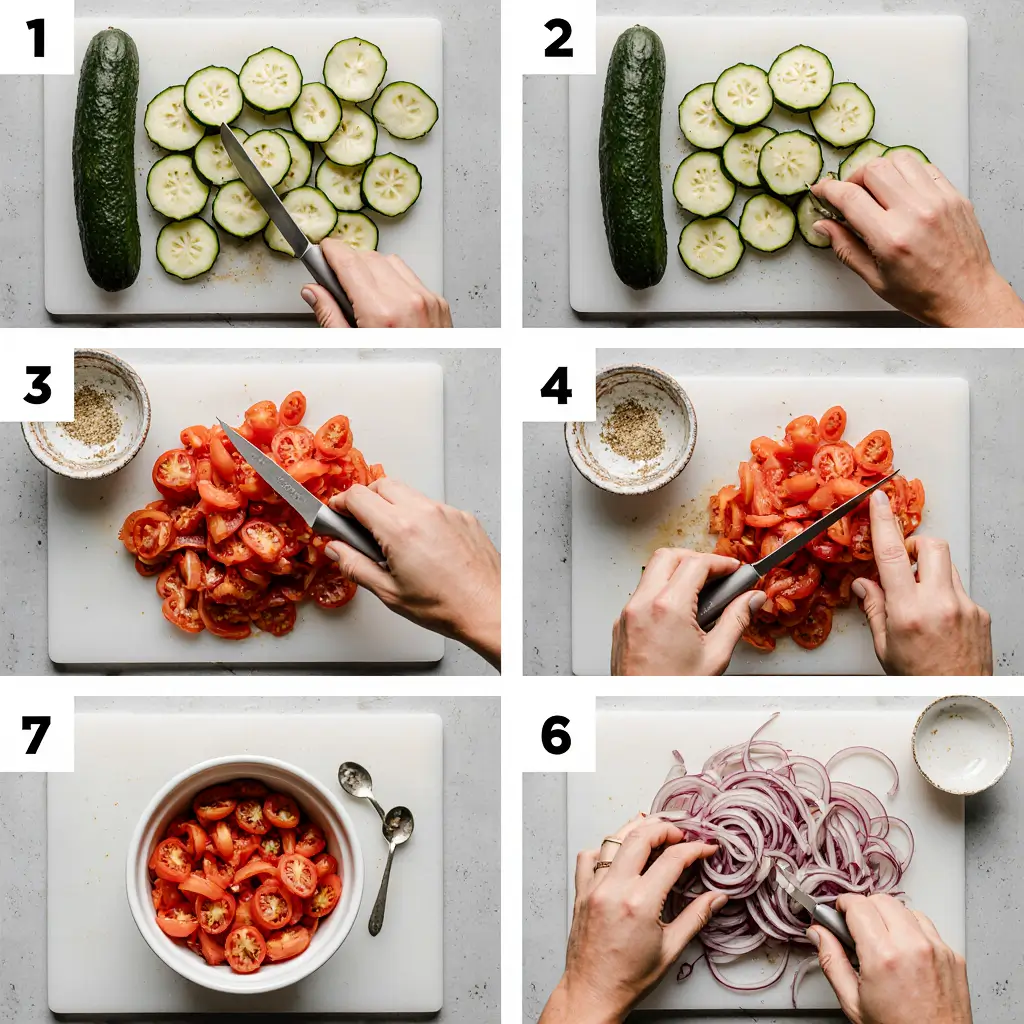
Fresh herbs can transform your salad from simple to spectacular. Basil, parsley, dill, and mint all work wonderfully with this combination. Add herbs just before serving to maintain their vibrant color and fresh flavor.
Creative Dressing Variations for Your Cucumber Tomato Onion Salad
The dressing you choose for your cucumber tomato onion salad can completely transform its character, taking it from a simple side dish to a gourmet experience. The beauty of this salad lies in its versatility—it pairs beautifully with everything from simple vinaigrettes to more complex flavor combinations.
Classic Vinaigrette Combinations
A traditional vinaigrette is often the perfect complement to cucumber tomato onion salad. The classic combination of olive oil and vinegar creates a light, refreshing dressing that enhances rather than masks the natural flavors of the vegetables. Use a ratio of about 3:1 oil to vinegar, and choose a high-quality extra virgin olive oil for the best flavor.
Red wine vinegar is the traditional choice, but don’t be afraid to experiment with other varieties. Balsamic vinegar adds a sweet complexity, while apple cider vinegar provides a subtle fruity note. White wine vinegar offers a clean, crisp flavor that works particularly well with the fresh vegetables.
For added depth, consider incorporating Dijon mustard into your vinaigrette. Just a teaspoon can emulsify the dressing and add a subtle tang that complements the onions beautifully. Honey can balance the acidity and add a touch of sweetness that pairs wonderfully with the tomatoes.
Mediterranean-Inspired Flavors
Transform your cucumber tomato onion salad into a Mediterranean masterpiece by incorporating flavors inspired by Greek and Italian cuisine. A Greek-style dressing featuring olive oil, lemon juice, oregano, and a touch of garlic creates a bright, herbaceous flavor profile that’s absolutely divine.
For an Italian twist, try combining olive oil with balsamic vinegar, fresh basil, and a sprinkle of Parmesan cheese. The umami from the cheese adds depth while the basil provides that classic Italian flavor that pairs so well with tomatoes.
Consider adding Mediterranean ingredients like kalamata olives, crumbled feta cheese, or capers to create a more substantial salad that can serve as a light meal rather than just a side dish.
International Fusion Approaches
Why limit yourself to traditional Western flavors? Your cucumber tomato onion salad can be the canvas for exploring international cuisine. An Asian-inspired dressing using rice vinegar, sesame oil, and a touch of soy sauce creates an entirely different flavor profile that’s both refreshing and exciting.
For a Middle Eastern twist, try a dressing made with lemon juice, olive oil, and sumac—a tangy spice that adds both flavor and a beautiful reddish color. Fresh mint and parsley complete this flavor profile beautifully.
Mexican-inspired variations might include lime juice, olive oil, and a touch of cumin, with fresh cilantro and perhaps some diced jalapeños for heat. The lime’s acidity brightens the vegetables while the cumin adds warmth and complexity.
Nutritional Benefits and Health Advantages of Cucumber Tomato Onion Salad
Your cucumber tomato onion salad isn’t just delicious—it’s also a nutritional powerhouse that can contribute significantly to your daily health goals. Understanding the nutritional benefits of each ingredient can help you appreciate just how good this simple salad is for your body.
Cucumber’s Hydration and Detox Properties
Cucumbers are composed of about 96% water, making them one of the most hydrating foods you can eat. This high water content makes cucumber tomato onion salad an excellent choice for maintaining proper hydration, especially during hot summer months. The water in cucumbers isn’t just plain H2O—it contains electrolytes and minerals that help your body maintain proper fluid balance.
Cucumbers are also rich in antioxidants, including vitamin C and beta-carotene, which help protect your cells from damage caused by free radicals. They contain compounds called cucurbitacins, which have been studied for their potential anti-inflammatory properties. The silica in cucumber skin supports healthy skin, hair, and nails, making this salad a beauty treatment from the inside out.
The fiber content in cucumbers, while modest, contributes to digestive health and helps you feel satisfied longer. This makes cucumber tomato onion salad an excellent choice for those looking to maintain a healthy weight while still enjoying flavorful, satisfying food.
Tomatoes’ Antioxidant Power
Tomatoes are perhaps best known for their high lycopene content, a powerful antioxidant that gives them their beautiful red color. Lycopene has been extensively studied for its potential health benefits, including supporting heart health and possibly reducing the risk of certain types of cancer. Interestingly, lycopene is actually more bioavailable in cooked tomatoes, but fresh tomatoes still provide significant amounts of this important compound.
Beyond lycopene, tomatoes are rich in vitamin C, potassium, and folate. Vitamin C supports immune function and helps your body absorb iron from other foods. Potassium is essential for heart health and blood pressure regulation, while folate is crucial for cell division and DNA synthesis.
The natural sugars in tomatoes provide quick energy, while their high water content contributes to hydration. The combination of nutrients in tomatoes makes them an excellent addition to any healthy diet, and their natural umami flavor enhances the overall taste of your cucumber tomato onion salad.
Onions’ Immune-Boosting Compounds
Onions are nutritional superstars that bring much more to your cucumber tomato onion salad than just flavor. They’re rich in quercetin, a powerful antioxidant that has anti-inflammatory properties and may help support immune function. Quercetin is particularly concentrated in the outer layers of the onion, so don’t peel away too much of the onion when preparing your salad.
The sulfur compounds in onions, which are responsible for their sharp flavor and tear-inducing properties, also provide significant health benefits. These compounds may help support cardiovascular health and have been studied for their potential anti-cancer properties. They also give onions their natural antibiotic properties, which have been recognized in traditional medicine for centuries.
Onions are also a good source of vitamin C, fiber, and various B vitamins. The prebiotic fiber in onions helps support healthy gut bacteria, contributing to overall digestive health and potentially boosting immune function.
Serving Suggestions and Pairing Ideas
The versatility of cucumber tomato onion salad makes it an ideal companion for countless meals and occasions. Understanding how to pair this salad with other dishes can help you create memorable dining experiences that showcase its fresh, clean flavors.
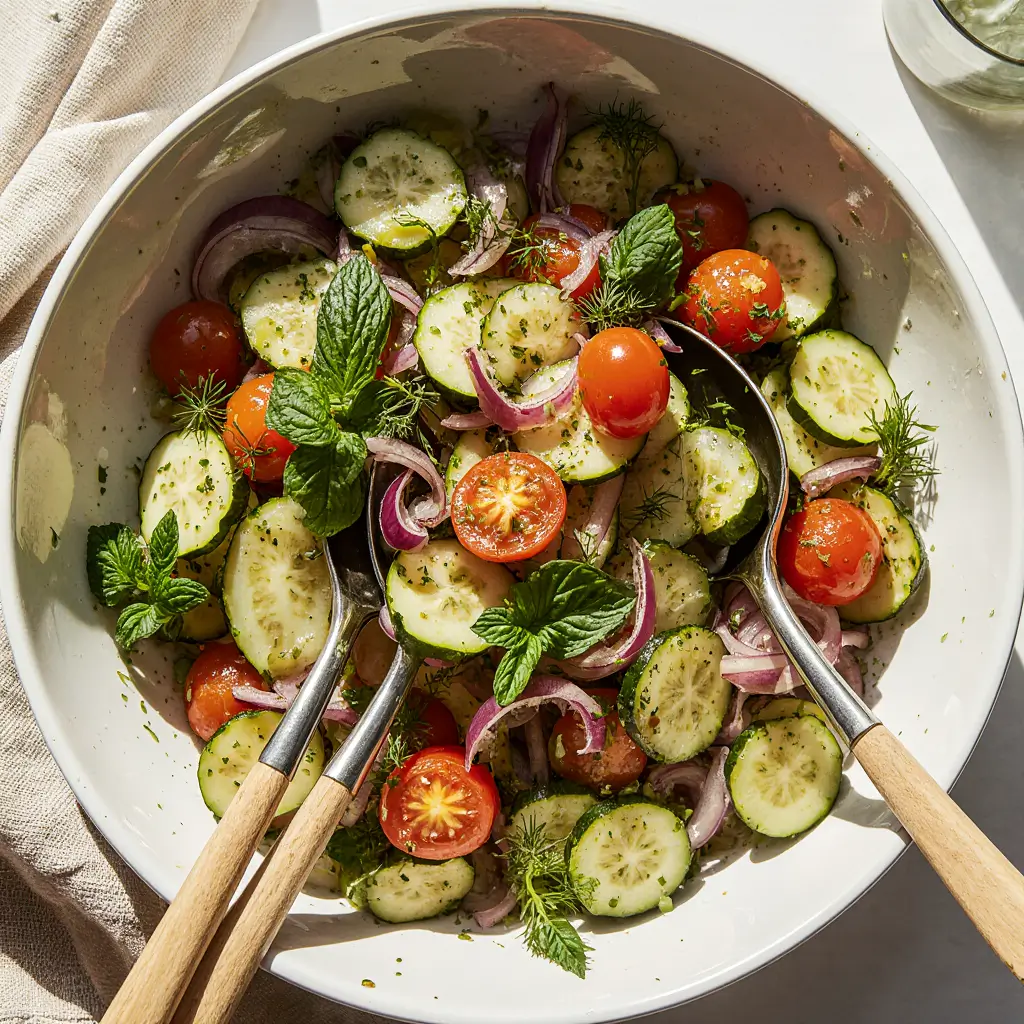
Perfect Protein Pairings
Your cucumber tomato onion salad pairs beautifully with a wide variety of proteins, making it an excellent choice for both casual and formal dining occasions. Grilled chicken breast, with its mild flavor and tender texture, provides the perfect canvas for the salad’s bright, fresh flavors. The acidity in the salad’s dressing can actually help tenderize the chicken if you choose to marinate them together.
Fish and seafood are natural partners for this refreshing salad. Grilled salmon, with its rich, buttery flavor, creates a beautiful contrast with the crisp vegetables. Shrimp, whether grilled, boiled, or pan-seared, adds protein without overwhelming the delicate flavors of the salad. For a Mediterranean twist, try pairing your salad with grilled halibut or sea bass.
Red meat lovers shouldn’t feel left out—cucumber tomato onion salad provides a refreshing counterpoint to rich, grilled steaks or lamb chops. The salad’s acidity helps cut through the richness of the meat, cleansing the palate between bites and making each taste more distinct and enjoyable.
Complementary Side Dishes
While cucumber tomato onion salad is often served as a side dish itself, it can also be part of a larger spread of complementary dishes. Consider serving it alongside other fresh salads like coleslaw or potato salad for a variety of textures and flavors. The crisp freshness of the cucumber tomato onion salad provides a nice contrast to creamier side dishes.
Grain-based salads like quinoa tabbouleh or rice pilaf pair wonderfully with cucumber tomato onion salad, creating a more substantial meal while maintaining the fresh, healthy theme. The salad’s bright flavors can help lighten heavier grain dishes and add crucial vitamins and minerals to the meal.
For barbecue or outdoor dining, consider pairing your salad with grilled vegetables like zucchini, bell peppers, or eggplant. The combination of fresh and grilled vegetables creates an interesting contrast in textures and flavors while keeping the meal light and healthy.
Seasonal Menu Integration
The beauty of cucumber tomato onion salad lies in its adaptability to different seasons and occasions. During summer months, when tomatoes and cucumbers are at their peak, this salad becomes the star of picnics, barbecues, and outdoor gatherings. Its refreshing nature makes it perfect for hot weather dining, providing cooling relief and essential hydration.
In spring, when fresh herbs are abundant, you can experiment with different herb combinations to create unique flavor profiles. Fresh dill, mint, or chives can transform the salad’s character while maintaining its essential freshness.
Even in fall and winter, when local tomatoes may not be available, you can still enjoy variations of this salad using greenhouse-grown or imported tomatoes. Consider adding warming spices like cumin or paprika to make the salad more suitable for cooler weather.
Storage Tips and Make-Ahead Strategies
Proper storage and preparation techniques can help you enjoy your cucumber tomato onion salad at its best, whether you’re meal prepping for the week or preparing for a special occasion. Understanding how each ingredient behaves over time will help you make the best decisions about preparation and storage.
Optimal Storage Conditions
The key to maintaining the quality of your cucumber tomato onion salad lies in understanding how different ingredients respond to storage. Cucumbers are particularly sensitive to moisture and can become soggy quickly if not stored properly. If you’re preparing your salad in advance, consider storing the cucumbers separately and adding them just before serving to maintain their crispness.
Tomatoes, on the other hand, can actually improve in flavor when they’re dressed and allowed to marinate for a short time. The salt in the dressing helps draw out their natural juices, creating a more flavorful base for the salad. However, be careful not to let dressed tomatoes sit too long, as they can become mushy and release too much liquid.
Onions are the most stable ingredient in your cucumber tomato onion salad and can be dressed and stored for several hours without significant changes in texture or flavor. In fact, allowing onions to marinate in the dressing can help mellow their sharpness and create a more harmonious flavor profile.
Make-Ahead Preparation Methods
If you’re planning to serve cucumber tomato onion salad at a gathering or want to prep it for weekday meals, strategic preparation can save you time while ensuring optimal quality. Prepare your dressing in advance—most vinaigrettes actually improve in flavor when they’re allowed to sit for a few hours or overnight, as the flavors have time to meld together.
You can also prepare your vegetables in advance, storing them separately in the refrigerator. Slice your onions and store them in a covered container, where they’ll keep for several days. Tomatoes can be cut and stored for a day or two, though they’re best used within 24 hours of cutting for optimal flavor and texture.
Cucumbers are best cut fresh, but if you need to prepare them in advance, store them in a single layer on paper towels in the refrigerator. This helps absorb excess moisture and keeps them crisp for longer.
Refreshing Leftover Salad
If you have leftover cucumber tomato onion salad, don’t despair—with a few simple techniques, you can refresh it and make it taste nearly as good as when it was first prepared. Start by draining any excess liquid that may have accumulated in the bottom of the bowl. This liquid, while flavorful, can make the salad soggy if left to sit.
Add fresh herbs to brighten the flavors and provide new aromatics. A squeeze of fresh lemon juice can also help reinvigorate the salad’s brightness. If the salad seems too acidic after sitting, a small drizzle of olive oil can help balance the flavors.
Consider adding fresh ingredients to stretch the salad and improve its texture. Fresh cucumber slices, cherry tomatoes, or even some crisp lettuce can help restore the salad’s appealing texture and make it more enjoyable to eat.
Recipe Variations and Ingredient Combinations
| Variation | Additional Ingredients | Dressing Style | Best Served With |
|---|---|---|---|
| Greek Style | Feta cheese, olives, oregano | Lemon-olive oil | Grilled lamb, pita bread |
| Italian Caprese | Fresh mozzarella, basil | Balsamic vinaigrette | Grilled chicken, crusty bread |
| Mexican Inspired | Avocado, cilantro, jalapeños | Lime-cumin dressing | Grilled fish, tortilla chips |
| Asian Fusion | Sesame seeds, scallions | Rice vinegar-sesame oil | Grilled tofu, steamed rice |
| Mediterranean | Capers, fresh herbs | Herb vinaigrette | Grilled fish, quinoa |
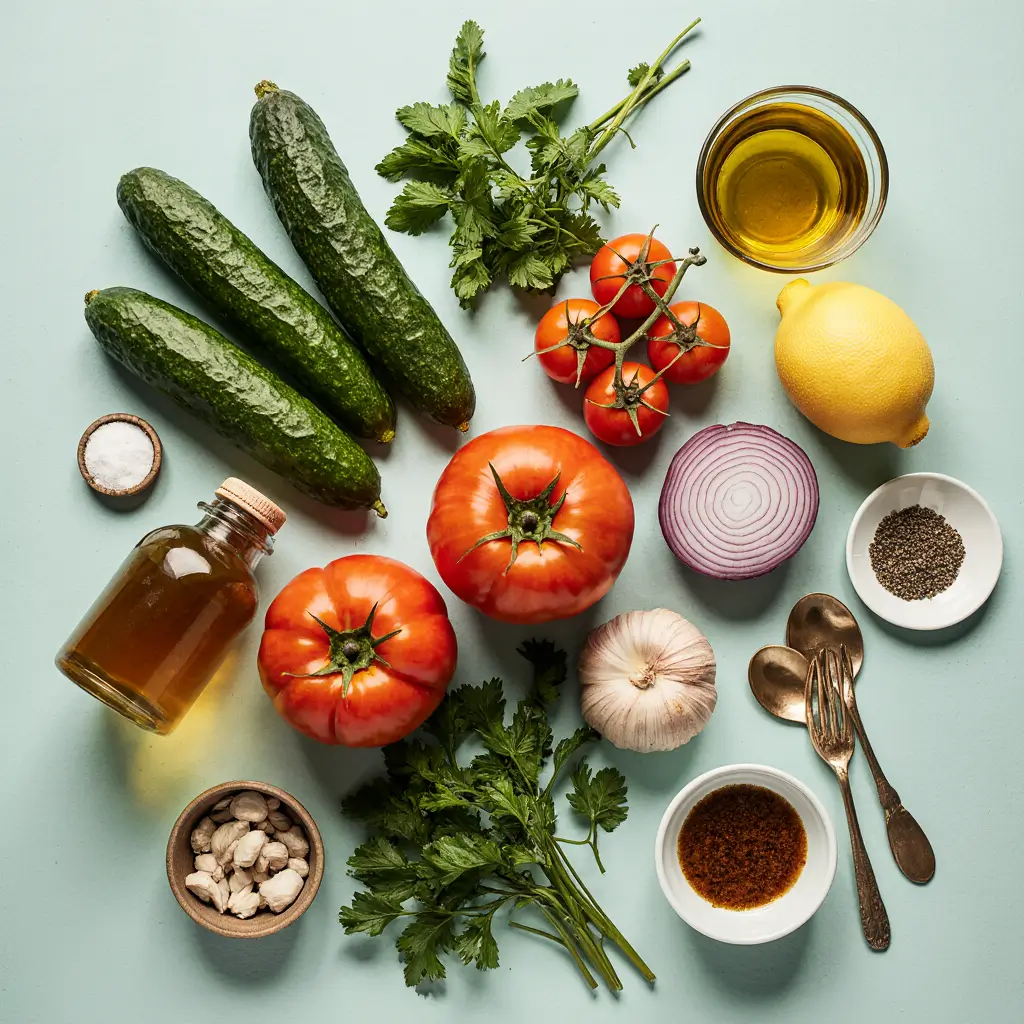
Nutritional Information per Serving
| Nutrient | Amount per Cup | % Daily Value |
|---|---|---|
| Calories | 25-40 | 1-2% |
| Carbohydrates | 6-8g | 2-3% |
| Fiber | 1-2g | 4-8% |
| Protein | 1-2g | 2-4% |
| Fat | 0-10g* | 0-15%* |
| Vitamin C | 15-20mg | 20-25% |
| Potassium | 200-300mg | 6-9% |
| Folate | 15-25mcg | 4-6% |
*Fat content depends on dressing used
Frequently Asked Questions About Cucumber Tomato Onion Salad
How long can cucumber tomato onion salad be stored in the refrigerator?
Cucumber tomato onion salad is best enjoyed fresh, but it can be stored in the refrigerator for up to 2-3 days. However, the quality will decline over time as the vegetables release moisture and the cucumbers may become soggy. For best results, store the salad in an airtight container and drain any excess liquid before serving leftover portions. If you’re planning to make this salad ahead of time, consider adding the cucumbers just before serving to maintain their crispness.
Can I make cucumber tomato onion salad without onions for sensitive stomachs?
Absolutely! While onions add a wonderful sharp flavor to cucumber tomato onion salad, they can be omitted or substituted for those with sensitive stomachs or dietary restrictions. Try using finely chopped chives, scallions (green parts only), or even a small amount of garlic powder for flavor. You could also add fresh herbs like basil, parsley, or dill to maintain the salad’s complexity without the harsh bite of raw onions. The salad will still be delicious and refreshing without them.
What’s the best way to prevent my cucumber tomato onion salad from becoming watery?
To prevent your cucumber tomato onion salad from becoming watery, try these techniques: Salt your cucumber slices and let them drain for 15-20 minutes before adding them to the salad. This draws out excess moisture. Choose firm, ripe tomatoes and remove the seeds if they’re particularly juicy. Add the dressing just before serving, or store the dressing separately and combine when ready to eat. If your salad does become watery, simply drain the excess liquid and add fresh herbs or a squeeze of lemon juice to brighten the flavors.
Can cucumber tomato onion salad be part of a weight loss diet?
Yes, cucumber tomato onion salad can be an excellent addition to a weight loss diet! This salad is naturally low in calories (typically 25-40 calories per cup without heavy dressing), high in water content for hydration, and provides fiber that helps you feel full. The vegetables are nutrient-dense, providing vitamins and minerals without excess calories. To keep it weight-loss friendly, use a light vinaigrette or simply dress it with lemon juice and herbs rather than heavy, creamy dressings. The salad’s high water and fiber content can help you feel satisfied while consuming fewer calories.
Is it better to peel cucumbers for cucumber tomato onion salad?
Whether to peel cucumbers for your cucumber tomato onion salad depends on personal preference and the type of cucumbers you’re using. Cucumber peels contain valuable nutrients, including fiber and vitamin K, so leaving them on increases the nutritional value of your salad. English cucumbers have thin, tender skins that are pleasant to eat, while regular cucumbers may have thicker, more bitter skins. If you choose to peel, try peeling in alternating strips to create an attractive striped pattern while retaining some nutritional benefits. Always wash cucumbers thoroughly regardless of whether you peel them.
Ready to create your own perfect cucumber tomato onion salad? Start with the freshest ingredients you can find, experiment with different dressing combinations, and don’t be afraid to make it your own. This versatile salad is forgiving, delicious, and healthy—everything you want in a go-to recipe. Share your favorite variations in the comments below, and remember that the best salads are made with love and enjoyed with good company!
Are You Try This Recipe ?
There are no reviews yet. Be the first one to write one.

